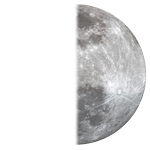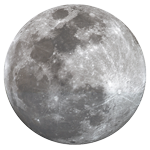
Stargazer
May 2024
Compiled by John Panek
This month we shift our attention back to the night sky with a potentially great Eta Aquariid meteor shower – the moon is favorable (New on May 7) and the Earth will pass close to a debris stream left by the parent Halley’s Comet around 3000 years ago. The radiant lies near Zeta (ζ) Aquarii and rises at 2:30 a.m. local daylight time in the continental U.S., reaching an altitude of 20° two hours later. Peak zenithal hourly rate is 50 meteors per hour but since the radiant is not overhead, observed rates are normally a dozen per hour, but rates May 3 may be higher due to our passage through the debris stream.
SCAS CELEBRATES
HONOR THE NIGHT
Ancient cultures measured time by the Moon's phases, the days of each cycle counted out. They knew when the Moon would wax and wane. Who today is aware whether the Moon is crescent, full or gibbous? We no longer honor the night sky. On a retreat with preteen students, far enough from city lights to see the cosmos, on a night when bright Venus cast a shadow, we asked them to turn off their flashlights, let their eyes adjust, Trust their steps in starlight. We honored the night sky.
Juliane Mc Adam, retired middle school language teacher, CA
BILL SADOWSKI PARK
The observing pad is open for public OBSERVATION
D’AURIA OBSERVATORY
The D'Auria Observatory is open for public OBSERVATION AND ASTROPHOTOGRAPHY
Lunar Timetable
 Last Quarter May 1st @ 7:27 am
Last Quarter May 1st @ 7:27 am New Moon May 7th @ 11:21 pm
New Moon May 7th @ 11:21 pm First Quarter May 15th @ 7:48 am
First Quarter May 15th @ 7:48 am Full Moon May 23rd @ 9:53 am
Full Moon May 23rd @ 9:53 amSOUTHERN CROSS OBSERVATION PAD
The popular free SOUTHERN CROSS OBSERVATION PAD HAS RE-OPENED in MIAMI-DADE BILL SADOWSKI Park! Come visit with us 7:30-10 p.m. Saturday's weather permitting. Bring `scopes & binocs, chairs, family, friends, colleagues, students, and bug repellent. Our SCAS Astros have introduced thousands to the awesome beauty of our seasonal night skies since 1986. Please dim headlights at the Park entrance SW 176 St./SW 79 Ave. 1/2 mile west of Old Cutler Road, Palmetto Bay 33157. The small parking lot is near the deck. Face masks are optional. Check the SCAS Facebook for weather/Holiday cancellations.
For astrophotography instruction visit our free D'AURIA outdoor observatory, Saturdays from dusk -10 P.M. 23325 SW 217 Avenue, Homestead 33031. Park outside the gate. No white lights, lanterns, lasers. litter, alcohol, or pets at both sites. For membership open www.scas.org
ENJOY SCAS PUBLIC STAR PARTIES: Weather permitting!
Saturday evenings dusk- 10 p.m.
SCAS Observation Pad in Miami-Dade Bill Sadowski Park SW 176 St./SW 79 Ave. Palmetto Bay 33157 free
D'Auria Observatory 23325 SW 217 Ave.dusk-10 p.m. astrophotograqphy information free No white lights, lanterns, lasers, litter, alcohol, or pets at either location.
METEOR SHOWERS THIS MONTH
eta Aquariids
April 15th to May 27th, 2024The Eta Aquariids are a strong shower when viewed from the southern tropics. From
the equator northward, they usually only produce medium rates of 10-30 per hour just
before dawn. Activity is good for a week centered the night of maximum activity. These
are swift meteors that produce a high percentage of persistent trains, but few fireballs.
There are predictions that this shower will be quite strong in 2024 due to interactions of
the particles with the planet Jupiter. Luckily, there will be little interference from the
waning crescent moon in 2024.
Shower details - Radiant: 22:30 -1° - ZHR: 50 - Velocity: 40.7 miles/sec (swift -
65.5km/sec) - Parent Object: 1P/Halley
Next Peak - The eta Aquariids will next peak on the May 4-5, 2024 night. On this night,
the moon will be 14% full.
Open the link: News and Information about Meteor Showers
Here are some tips on how to maximize your time looking for meteors and fireballs during any meteor shower:
- Get out of the city to a place where the city and artificial lights do not impede your viewing
- If you are out viewing the shower during its peak, you will not need any special equipment. You should be able to see the shower with your naked eyes.
- Carry a blanket or a comfortable chair with you - viewing meteors, just like any other kind of stargazing is a waiting game, and you need to be comfortable. Plus, you may not want to leave until you can't see the majestic celestial fireworks anymore.
In case you missed it......
October 2022 Sky & Telescope p. 62 features photos of our two famous SCAS astronomers. The late Don Parker, M.D., renowned Mars astrophotographer, and the late Tippy D'Auria, founder of our annual Winter Star Party were in a group of professional astronomers, editors, and photographers who drove to the Florida Keys in June 2001 to hopefully capture Martian flares of light. All were members of the Assoc. of Lunar & Planetary Observers. The intriguing article begins on P. 59.
BRIGHT COMETS THIS MONTH
Comet 12P Pons-Brooks
Visible just after sunset in Taurus at magnitude 4.6
13P/Olbers
Will reach perihelion in late June. Begins the month in Taurus at magnitude 8.4, brightening rapidly this month moving up into Auriga
Open the link: News and information about Bright Comets
SCAS EVENTS
SATURDAY EVENINGS
When night skies gradually improve in clarity as the Monsoon season winds down, our SCAS Observing sites will open to members and the public.
D`AURIA OBSERVATORY- 23325 SW 217 Ave. Homestead 33031 opens 7:30 -10 p.m. for astrophotography assistance and general observing.
S. CROSS OBSERVATORY, MiamiDade Bill Sadowski Park 8-10 p.m. SW 176 St./SW 79 Ave..
Palmetto Bay 33157 for equipment assistance. and grand tour of the night sky if weather permits.
In our 37th year at the Park offering successful astronomy education for the public.
No white lights, lasers, flashlights, lanterns, litter, alcohol or pets at both sites Free.
We operate by starlight !
SCAS HAM RADIO
Recently, member Dan Zuckerman replaced and upgraded his ham equipment. He was chatting with folks in Europe.
Do we have some retired, or new SCAS ham operators who would like to establish a SCAS radio dept?
It could become very convenient, or necessary in certain future conditions. Consider the astronomy information shared and maybe international SCAS members!
Contact me (Barb) if you wish to link up with Dan. barbyager@aol.com.
SOLAR VIEWING
TOTAL SOLAR ECLIPSE 04/08
Weather permitting SCAS needs solar telescopes at the "front door" to ZooMiami 12400 SW 152nd st, starting this month
There will be large crowds of families. Please CONTACT ME ASAP if you can bring equipment, We are restoring our popular solarviewing events at ZooMiami.
Plans need to be made in advance. Updates will be sent out to members soon.
Interested to join our new solar team? Contact me: barbyager@aol.com . If you have solar equipment or want to help, please send an email to Dr. Lester Shalloway with
your information: drlester3@aol.com.
IN THE SKY
May is a great month for Spring galaxies - check out the Needle (NGC 4565) in Coma Berenices and the
Sombrero (M104) in Virgo. Early May affords an opportunity to see the crescent Moon near Mars, Saturn, and
Mercury just before Sunrise. Greatest elongation of Mercury is May 9, at 26 degrees.
NASA NEWS
The PACE (Plankton, Aerosol, Cloud, ocean Ecosystem) observatory launched
February 8 (witnessed by some of us at Scout Key during WSP 2024!) and has completed on-orbit commissioning and calibration. Wonderful science
images are at https://www.nasa.gov/earth/nasas-pace-data-on-ocean-atmosphere-climate-now-available/
Boeing's Starliner will take
ISS - Miami Track
ISS Passes for Miami – 18 good ones in May, 5 of them in the mornings in the first half of the month and 13 in the evenings all through the month
Date Mag Start Time Alt. Az. Highest Alt. Az. End Time Alt. Az.
8-May -0.2 5:37:01 10° NNE 5:37:56 11° NE 5:38:50 10° NE
8-May -2 20:35:54 10° SSE 20:37:39 14° SE 20:37:56 14° ESE
9-May -3.4 21:21:26 10° SW 21:24:43 64° NW 21:28:02 10° NE
10-May -1.8 5:33:08 10° NNW 5:36:09 32° NE 5:39:09 10° ESE
10-May -3.7 20:32:10 10° SSW 20:35:25 53° SE 20:38:40 10° NE
10-May -0.1 22:12:03 10° NW 22:12:17 10° NW 22:12:32 10° NW
11-May -0.7 4:44:27 10° N 4:46:41 17° NE 4:48:55 10° E
11-May -0.7 21:20:20 10° W 21:22:44 18° NW 21:25:08 10° N
12-May -3.9 5:30:46 10° NW 5:34:02 60° SW 5:37:16 10° SSE
12-May -1.9 20:30:09 10° WSW 20:33:14 35° NW 20:36:20 10° NNE
13-May -2.2 4:46:05 29° ESE 4:46:05 29° ESE 4:47:54 10° SE
14-May -0.4 20:29:50 10° WNW 20:31:11 12° NW 20:32:33 10° NNW
27-May -0.6 22:43:37 10° NNW 22:44:11 14° NNW 22:44:11 14° NNW
28-May -1.8 21:54:16 10° N 21:56:19 21° NNE 21:56:19 21° NNE
29-May -1.3 21:05:34 10° NNE 21:06:56 12° NE 21:08:17 10° ENE
29-May -0.7 22:40:33 10° WNW 22:41:18 15° WNW 22:41:18 15° WNW
30-May -3.6 21:50:33 10° NW 21:53:31 68° NNW 21:53:31 68° NNW
31-May -2.8 21:00:53 10° NNW 21:03:57 34° NE 21:05:46 19° E
Open the Link: News and Information about ISS passes over Miami.
Contribute
Have something interesting and astronomy related you would like to contribute? Send a brief 1-2 paragrapharticle to our Stargazer editor: 350.john@gmail.com
Evening
May 11: The Crescent Moon highlights Mare Crisium
May 23: Mostly Full Moon occults Antares 9:13 pm to 10:19 pm for Miami
Morning
May 3: Crescent Moon approaches Saturn and Mars
May 4: Moon near Neptune and Mars
May 5: Eta-Aquariid Meteor Shower peak
May 31: Mercury is a thumb's width from Uranus
Constellations
The northern
